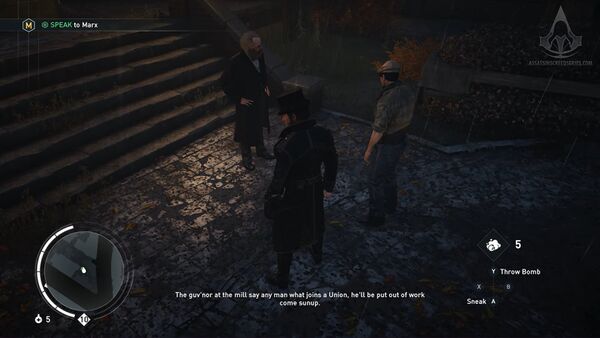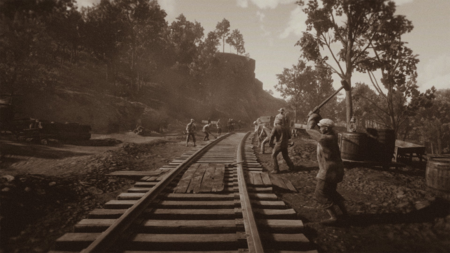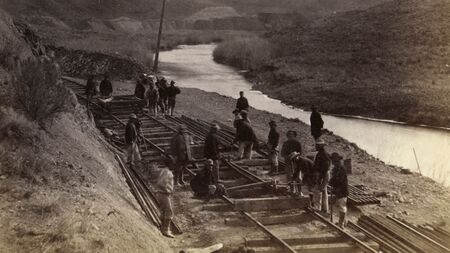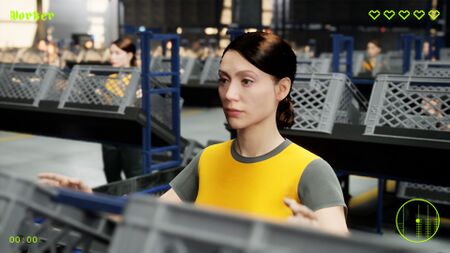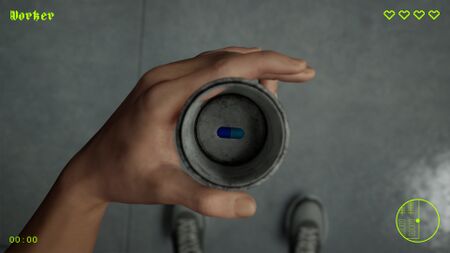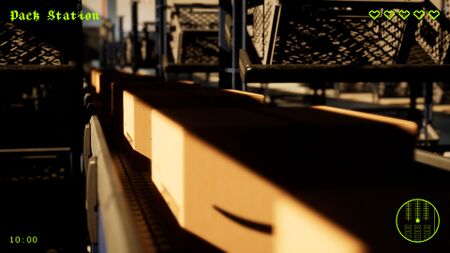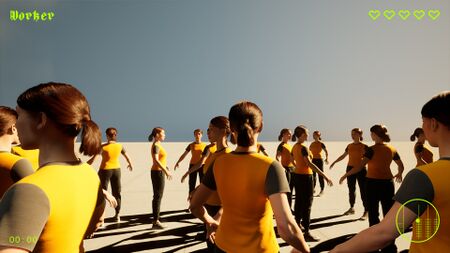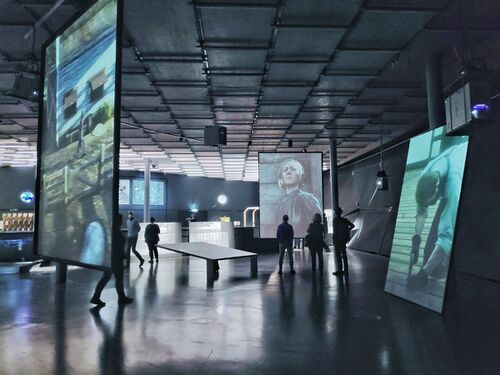User:Berna Bereit Master Thesis Project Proposal: Difference between revisions
Berna Bereit (talk | contribs) No edit summary |
Berna Bereit (talk | contribs) |
||
| (29 intermediate revisions by the same user not shown) | |||
| Line 1: | Line 1: | ||
»I wonder if it is not time for game design to start being a spatial exercise tool through which we, protesters, can practice and acquire urban tactics that stand against the state’s oppression?« (Bashady, 2022) | ''»I wonder if it is not time for game design to start being a spatial exercise tool through which we, protesters, can practice and acquire urban tactics that stand against the state’s oppression?« (Bashady, 2022)'' | ||
== What do you want to make? == | == <span style="font-family: Poppins; "> What do you want to make? == | ||
''Between | ''Between Real and Realistic'' (working title) is a publication which is accompanied by two smaller projects: the thesis and an installation. | ||
Within the publication the thesis will be | Within the publication the thesis will be expanded, analysing the representation of labour and trade unions in games as well as in the game industry. A more profound insight on different sequences of games and the connection to media and social theory can be gained. | ||
The interactive installation focuses on the visual content that is analysed in the publication, drawing selective attention on game recordings and trade unions within the video game industry. This includes the examination of narrative strands, game mechanics and aesthetic elements that focus on class struggles and collective organisations in games such as Red Dead Redemption 2 and Bioshock Infinite. | The interactive installation provides additional video material to the publication and focuses on the visual content that is analysed in the publication, drawing selective attention on game recordings and trade unions within the video game industry. This includes the examination of narrative strands, game mechanics and aesthetic elements that focus on class struggles and collective organisations in games such as Red Dead Redemption 2, Assassin’s Creed: Syndicate and Bioshock Infinite. | ||
Directed towards players and game enthusiasts, the project adds a perspective besides consuming/playing games, proposing a reality to those apparently fictional game worlds. | Directed towards players and game enthusiasts, the project adds a perspective besides consuming/playing games, proposing a reality to those apparently fictional game worlds.[[File:Between-real-and-realistic installation mockup02.png|center|thumb|500x500px|mock-up of the installation]] | ||
== <span style="font-family: Poppins; "> How do you plan to make it? == | |||
The publication will be an expansion of the thesis, a combination of reading theory, interviews and papers in the field of media, game and social theory which will then be used to analyse selected game sequences. Therefore the narratives and gamespaces will be observed with the photography mode of the games drawing attention to the side stories of the main plot. Depending on the availability of the game, also game blogs and walkthroughs on YouTube will be included. Since in the book(let) only text and images can be used to display the content, short video game sequences will be recorded as part of the interactive installation. These video excerpts give a more precise insight into the specific scenes. Combined with an additional layer, people can hover over highlighted spots which then reveal text information about the historical context, the gamespaces, the characters or their relation to reality. | |||
[[File:Karl-marx-storyline-4.jpg|center|thumb|600x600px|Screenshot, Assassin's Creed: Syndicate (2015), Worker speaking to Karl Marx]] | |||
For example the workers of the Central Union Railroad Camp in Red Dead Redemption 2 which are encountered in three missions, are based on the history of the first transcontinental railroad in the USA which was built between 1863 and 1869 mostly by Chinese migrants. Being paid not even half of the wage as the white workers, 3,000 Chinese workers went on strike in 1867 (Shashkevich, 2019). In Red Dead Redemption 2 the workers can be read as Chinese not only by their outward appearance, but also by the Cantonese they seem to speak. Different to the historic context, the time setting is dated to 1899 when players encounter the Camp as Arthur Morgan for the first time. Yet the game only makes use of some selective elements, which make the gamespace more realistic, but very little give context about actual events. | |||
[[File:Central-union-railroad-camp-03.png|left|thumb|450x450px|Screenshot, Red Dead Redemption 2, Central Union Railroad Camp, photo mode filter used]] | |||
[[File:Hart curving iron 5818.jpg|center|thumb|450x450px|Workers lay track along the Ten Mile Canyon stretch of the Transcontinental Railroad. Image credit: Alfred A. Hart Photographs, 1862-1869, Department of Special Collections, Stanford University Libraries]] | |||
'' | == <span style="font-family: Poppins; "> Timetable == | ||
'''<span style="font-family: Poppins; "> October - November''' | |||
Start with the Research on the topic and find different games that will be analysed. The goal is to gain an overview of the topic, what other researchers or designers/artists have explored in this field. As part of the public moment a small audio will be created that gives an introduction to the topic. QR codes will be printed on transparent paper which are placed in the toilet cabinets of the 4th floor at Wijnhaven 61 - while taking a toilet break, people can listen to the audio. By the end of November the project proposal has to be finished and by that also a first exploration of the topic. With the focus on creating a publication and publishing, I will search for potential bookshops and zine fairs to reach out. | |||
'' | ''<span style="color: blue; ">4th November 2024 Public Moment'' | ||
''<span style="color: blue; ">22nd November 2024 Deadline Project Proposal'' | |||
'' | ''<span style="color: blue; ">27th November 2024 Pre-Assessment (12:20h to 12:40h)'' | ||
'''<span style="font-family: Poppins; "> December - February''' | |||
From December to February the Research and the analysis of the games will be completed and a coherent text will be produced. Since the aim is to produce an expansion of the thesis in the format of a book(let) containing more information about the topic, two texts will be produced. Once the thesis with around 8000 words and not necessarily finished by the end of February the book(let). | |||
'' | ''<span style="color: blue; ">13th December 2024 Draft First Chapter'' | ||
'' | ''<span style="color: blue; ">18th December 2024 Assessment (14:45h to 15:30h)'' | ||
'''<span style="font-family: Poppins; "> March - April''' | |||
Last feedback loops on the thesis. Parallel video game sequences will be recorded and embedded into the interface of the installation to be tested by a handful of selected people (from game enthusiasts to non gamers). | |||
== Why do you want to make it? == | ''<span style="color: blue; ">14th March 2025 Deadline First Draft Thesis'' | ||
''<span style="color: blue; ">18th April 2025 Deadline Thesis'' | |||
'''<span style="font-family: Poppins; "> May - June''' | |||
The collection of analysed game material will be transformed into an installation showing the findings of the project. Furthermore the thesis will be extended and layouted into a book(let) therefore I will test out different ways of book binding, exploring how the publication itself can be playful making use of ludic elements of games (different ways of folding to guide the direction of reading, using different papers to create layers of information, etc.). Mid May a small setup of the installation will be made and players and game enthusiasts will be invited to test it. This will help to finalise the displayed content and how to interact with it. | |||
''<span style="color: blue; ">End June 2025 Graduation Show'' | |||
== <span style="font-family: Poppins; "> Why do you want to make it? == | |||
Having played video games from an early age and always being fascinated by the in-game worlds, I am still eager to observe and research in this field. At the same time this topic is socially and culturally significant, as video games are a growing medium that is increasingly used as a platform for social and political discourse. The representation of trade unions and labour movements in games not only reflects historical and contemporary conflicts, but also provides a framework to address system criticism, solidarity and collective action. The analysis helps to understand how the visual and narrative design of games affects the perception of social realities and to what extent these representations can stimulate reflection on labour struggles. | Having played video games from an early age and always being fascinated by the in-game worlds, I am still eager to observe and research in this field. At the same time this topic is socially and culturally significant, as video games are a growing medium that is increasingly used as a platform for social and political discourse. The representation of trade unions and labour movements in games not only reflects historical and contemporary conflicts, but also provides a framework to address system criticism, solidarity and collective action. The analysis helps to understand how the visual and narrative design of games affects the perception of social realities and to what extent these representations can stimulate reflection on labour struggles. | ||
== Who can help you and how? == | == <span style="font-family: Poppins; "> Who can help you and how? == | ||
Looking from a closer circle to a more outward perspective, XPUB2 game enthusiasts can be a group to share and test things. Lidia would be a great input since she is researching in the field of games as part of her PhD. Likewise trade unions (vakbond) in the Netherlands or small game development collectives could give an insightful perspective on their work. | Looking from a closer circle to a more outward perspective, XPUB2 game enthusiasts can be a group to share and test things. Lidia would be a great input since she is researching in the field of games as part of her PhD. Likewise trade unions (vakbond) for game developers in the Netherlands or small game development collectives could give an insightful perspective on their work. | ||
== Relation to previous practice == | == <span style="font-family: Poppins; "> Relation to previous practice == | ||
In my bachelor's thesis ‘GamingWell - WorkingWell’, I already dealt with the instrumentalisation of gaming in Amazon's fulfilment centres. This consisted of research in which I used the effects of automation, the physical strain on employees, gaming in the workplace and the suppression of trade union work to theoretically explain why Amazon fulfilment centres are by no means magical places. The research was then aesthetically translated into a video game by making the mechanisms playable in various scenarios and providing insights into the echo of a fulfilment centre. Staged as an installation in the exhibition context, visitors were able to experience realistic situations at various levels: From familiarising themselves with the work areas and playing simple mini-games to break up the monotonous, repetitive work, to deciding for or against painkillers during working hours, to forming a trade union. The scenarios are based on current developments. | In my bachelor's thesis ‘GamingWell - WorkingWell’, I already dealt with the instrumentalisation of gaming in Amazon's fulfilment centres. This consisted of research in which I used the effects of automation, the physical strain on employees, gaming in the workplace and the suppression of trade union work to theoretically explain why Amazon fulfilment centres are by no means magical places. The research was then aesthetically translated into a video game by making the mechanisms playable in various scenarios and providing insights into the echo of a fulfilment centre. Staged as an installation in the exhibition context, visitors were able to experience realistic situations at various levels: From familiarising themselves with the work areas and playing simple mini-games to break up the monotonous, repetitive work, to deciding for or against painkillers during working hours, to forming a trade union. The scenarios are based on current developments.[[File:Gg-01.jpg|left|thumb|450x450px|GamingWell - WorkingWell, 2023, pick station with worker]] | ||
[[File:Gg-04.jpg|left|thumb|450x450px|GamingWell - WorkingWell, 2023, painkillers from vending machine]] | |||
[[File:Gg-03.jpg|thumb|450x450px|GamingWell - WorkingWell, 2023, conveyor belt with Amazon packages|center]] | |||
[[File:Gg-05.jpg|thumb|450x450px|GamingWell - WorkingWell, 2023, collective walkout|center]] | |||
== Relation to larger context == | |||
'''»'''NPCs are digital Sisyphus machines that have no perspective of breaking out of their activity loops. In the moments when the algorithm shows inconsistencies, the NPCs break out of the logic of total normality, and appear touchingly human.'''«''' (Total Refusal, 2022) | |||
The research builds on existing work in game studies, social theory and art studies that examine video games as a medium of social reflection. | |||
== References == | ''Between Real and Realistic'' (working title) is building on previous findings shifting the perspective from inside the games to outside — reality. While in GamingWell — WorkingWell the focus was on the effects of gamification at the workplace, now the focus is on how are games created, who has the agency and how do these games pretend to be based on history but at the same time being inaccurate for the purpose of attracting as many people to play as possible? At the same time the working conditions within the game development industry and crunch culture will be observed. Game developers are creating games about "heroes" saving overworked NPCs while being forced to crunch in order to finish the game itself. | ||
== <span style="font-family: Poppins; "> Relation to larger context == | |||
'''''»'''NPCs are digital Sisyphus machines that have no perspective of breaking out of their activity loops. In the moments when the algorithm shows inconsistencies, the NPCs break out of the logic of total normality, and appear touchingly human.'''«''' (Total Refusal, 2022)'' | |||
The research builds on existing work in game studies, social theory and art studies that examine video games as a medium of social reflection. Espen Aarseth and Stephan Günzel (2019) provide in »''Ludotopia: Spaces, Places and Territories in Computer Games''« an in-depth exploration of how spatiality is represented in computer games, focusing on the relationship between virtual spaces and real-world geography. This perspective offers a foundation for understanding historical events and sceneries that are turned into partly fictional game worlds. Hamza Bashady (2022) critiques how video games often neutralise or silence dissent in his article »''A Passive Mob: How Video Games Silence Dissent''«, revealing the tension between gameplay and socio-political resistance — a theme relevant to the representation of labour struggles. In »''Dystopia in the Skies: Negotiating Justice and Morality on Screen in the Video Game BioShock Infinite''« Stefan Schubert (2018) examines themes of justice and morality, providing a case study of how games negotiate complex socio-political ideas, potentially including those related to labour.»''Marx at the Arcade - Consoles, Controllers, and Class Struggles''« by Jamie Woodcock (2019) delves into the intersections of gaming and class struggles, presenting video games as a lens through which to understand broader issues of labour and capitalism. Bridging a theoretical perspective between fiction and reality, Eva Nieuwdorp (2005) discusses in»''The Pervasive Interface: Tracing the Magic Circle''« Johan Huizinga concept of the magic circle, emphasising the blurred boundaries between play and reality, a concept that could inform how labour issues are represented and experienced in games. | |||
At the same time, the consideration of current labour conditions (for example crunch culture) in the video game industry itself will add an additional, practice-relevant dimension to the project. Amanda Cote and Brandon Harris (2020) observe in »''Weekends became something other people did: Understanding and intervening in the habitus of video game crunch''« how the concept of habitus by Pierre Bourdieu (1990) can also be applied to the Crunch culture. Recent developments in unionisation within the gaming industry, such as the formation of a »wall-to-wall union« at Bethesda Game Studios (Kerr, 2024a) and the IWGB Game Workers’ manifesto launch in the UK (Kerr, 2024b), demonstrate the growing push for labour rights in the industry itself, connecting real-world activism to the themes explored in this project.[[File:Totalrefusal hardly kunsthaus-1920x-q80.jpg|center|thumb|500x500px|Total Refusal (2022): Hardly Working at Kunsthaus]] | |||
== <span style="font-family: Poppins; "> References == | |||
Aarseth, E., Günzel, S. (Eds.), 2019. Ludotopia: Spaces, Places and Territories in Computer Games. 1st ed, Edition Medienwissenschaft. transcript Verlag, Bielefeld, Germany. <nowiki>https://doi.org/10.14361/9783839447307</nowiki> | Aarseth, E., Günzel, S. (Eds.), 2019. Ludotopia: Spaces, Places and Territories in Computer Games. 1st ed, Edition Medienwissenschaft. transcript Verlag, Bielefeld, Germany. <nowiki>https://doi.org/10.14361/9783839447307</nowiki> | ||
| Line 64: | Line 84: | ||
Bashady, Hamza. 2022. A Passive Mob: How Video Games Silence Dissent. Online. URL: <nowiki>https://futuress.org/stories/a-passive-mob</nowiki>] | Bashady, Hamza. 2022. A Passive Mob: How Video Games Silence Dissent. Online. URL: <nowiki>https://futuress.org/stories/a-passive-mob</nowiki>] | ||
Cote, A.C., Harris, B.C., 2020. ‘Weekends became something other people did’: Understanding and intervening in the habitus of video game crunch. Convergence: The International Journal of Research into New Media Technologies 27, 161–176. <nowiki>https://doi.org/10.1177/1354856520913865</nowiki> | |||
| Line 79: | Line 99: | ||
NiZZULiVΞ (2013). BioShock Infinite Job Auction Bidding Citizens Town Square Plaza of Zeal Finkton. [online] YouTube. Available at: <nowiki>https://www.youtube.com/watch?v=4AVihhOrVUI</nowiki> [Accessed 1 Nov. 2024]. | NiZZULiVΞ (2013). BioShock Infinite Job Auction Bidding Citizens Town Square Plaza of Zeal Finkton. [online] YouTube. Available at: <nowiki>https://www.youtube.com/watch?v=4AVihhOrVUI</nowiki> [Accessed 1 Nov. 2024]. | ||
Robson, J., Grant, T. (Eds.), 2018. The Aesthetics of Videogames. 1. Edition. ed. Routledge, New York. | |||
Schubert, S., 2018. Dystopia in the Skies: Negotiating Justice and Morality on Screen in the Video Game BioShock Infinite. ejas. <nowiki>https://doi.org/10.4000/ejas.14089</nowiki> | |||
Total Refusal, 2022. Hardly Working. Online. URL: <nowiki>https://totalrefusal.com/home/hardly-working</nowiki> | |||
Shashkevich, A. (2019). Giving voice to Chinese railroad workers. [online] news.stanford.edu. Available at: <nowiki>https://news.stanford.edu/stories/2019/04/giving-voice-to-chinese-railroad-workers</nowiki>. | |||
Latest revision as of 14:06, 21 November 2024
»I wonder if it is not time for game design to start being a spatial exercise tool through which we, protesters, can practice and acquire urban tactics that stand against the state’s oppression?« (Bashady, 2022)
What do you want to make?
Between Real and Realistic (working title) is a publication which is accompanied by two smaller projects: the thesis and an installation.
Within the publication the thesis will be expanded, analysing the representation of labour and trade unions in games as well as in the game industry. A more profound insight on different sequences of games and the connection to media and social theory can be gained.
The interactive installation provides additional video material to the publication and focuses on the visual content that is analysed in the publication, drawing selective attention on game recordings and trade unions within the video game industry. This includes the examination of narrative strands, game mechanics and aesthetic elements that focus on class struggles and collective organisations in games such as Red Dead Redemption 2, Assassin’s Creed: Syndicate and Bioshock Infinite.
Directed towards players and game enthusiasts, the project adds a perspective besides consuming/playing games, proposing a reality to those apparently fictional game worlds.
How do you plan to make it?
The publication will be an expansion of the thesis, a combination of reading theory, interviews and papers in the field of media, game and social theory which will then be used to analyse selected game sequences. Therefore the narratives and gamespaces will be observed with the photography mode of the games drawing attention to the side stories of the main plot. Depending on the availability of the game, also game blogs and walkthroughs on YouTube will be included. Since in the book(let) only text and images can be used to display the content, short video game sequences will be recorded as part of the interactive installation. These video excerpts give a more precise insight into the specific scenes. Combined with an additional layer, people can hover over highlighted spots which then reveal text information about the historical context, the gamespaces, the characters or their relation to reality.
For example the workers of the Central Union Railroad Camp in Red Dead Redemption 2 which are encountered in three missions, are based on the history of the first transcontinental railroad in the USA which was built between 1863 and 1869 mostly by Chinese migrants. Being paid not even half of the wage as the white workers, 3,000 Chinese workers went on strike in 1867 (Shashkevich, 2019). In Red Dead Redemption 2 the workers can be read as Chinese not only by their outward appearance, but also by the Cantonese they seem to speak. Different to the historic context, the time setting is dated to 1899 when players encounter the Camp as Arthur Morgan for the first time. Yet the game only makes use of some selective elements, which make the gamespace more realistic, but very little give context about actual events.
Timetable
October - November
Start with the Research on the topic and find different games that will be analysed. The goal is to gain an overview of the topic, what other researchers or designers/artists have explored in this field. As part of the public moment a small audio will be created that gives an introduction to the topic. QR codes will be printed on transparent paper which are placed in the toilet cabinets of the 4th floor at Wijnhaven 61 - while taking a toilet break, people can listen to the audio. By the end of November the project proposal has to be finished and by that also a first exploration of the topic. With the focus on creating a publication and publishing, I will search for potential bookshops and zine fairs to reach out.
4th November 2024 Public Moment
22nd November 2024 Deadline Project Proposal
27th November 2024 Pre-Assessment (12:20h to 12:40h)
December - February
From December to February the Research and the analysis of the games will be completed and a coherent text will be produced. Since the aim is to produce an expansion of the thesis in the format of a book(let) containing more information about the topic, two texts will be produced. Once the thesis with around 8000 words and not necessarily finished by the end of February the book(let).
13th December 2024 Draft First Chapter
18th December 2024 Assessment (14:45h to 15:30h)
March - April
Last feedback loops on the thesis. Parallel video game sequences will be recorded and embedded into the interface of the installation to be tested by a handful of selected people (from game enthusiasts to non gamers).
14th March 2025 Deadline First Draft Thesis
18th April 2025 Deadline Thesis
May - June
The collection of analysed game material will be transformed into an installation showing the findings of the project. Furthermore the thesis will be extended and layouted into a book(let) therefore I will test out different ways of book binding, exploring how the publication itself can be playful making use of ludic elements of games (different ways of folding to guide the direction of reading, using different papers to create layers of information, etc.). Mid May a small setup of the installation will be made and players and game enthusiasts will be invited to test it. This will help to finalise the displayed content and how to interact with it.
End June 2025 Graduation Show
Why do you want to make it?
Having played video games from an early age and always being fascinated by the in-game worlds, I am still eager to observe and research in this field. At the same time this topic is socially and culturally significant, as video games are a growing medium that is increasingly used as a platform for social and political discourse. The representation of trade unions and labour movements in games not only reflects historical and contemporary conflicts, but also provides a framework to address system criticism, solidarity and collective action. The analysis helps to understand how the visual and narrative design of games affects the perception of social realities and to what extent these representations can stimulate reflection on labour struggles.
Who can help you and how?
Looking from a closer circle to a more outward perspective, XPUB2 game enthusiasts can be a group to share and test things. Lidia would be a great input since she is researching in the field of games as part of her PhD. Likewise trade unions (vakbond) for game developers in the Netherlands or small game development collectives could give an insightful perspective on their work.
Relation to previous practice
In my bachelor's thesis ‘GamingWell - WorkingWell’, I already dealt with the instrumentalisation of gaming in Amazon's fulfilment centres. This consisted of research in which I used the effects of automation, the physical strain on employees, gaming in the workplace and the suppression of trade union work to theoretically explain why Amazon fulfilment centres are by no means magical places. The research was then aesthetically translated into a video game by making the mechanisms playable in various scenarios and providing insights into the echo of a fulfilment centre. Staged as an installation in the exhibition context, visitors were able to experience realistic situations at various levels: From familiarising themselves with the work areas and playing simple mini-games to break up the monotonous, repetitive work, to deciding for or against painkillers during working hours, to forming a trade union. The scenarios are based on current developments.
Between Real and Realistic (working title) is building on previous findings shifting the perspective from inside the games to outside — reality. While in GamingWell — WorkingWell the focus was on the effects of gamification at the workplace, now the focus is on how are games created, who has the agency and how do these games pretend to be based on history but at the same time being inaccurate for the purpose of attracting as many people to play as possible? At the same time the working conditions within the game development industry and crunch culture will be observed. Game developers are creating games about "heroes" saving overworked NPCs while being forced to crunch in order to finish the game itself.
Relation to larger context
»NPCs are digital Sisyphus machines that have no perspective of breaking out of their activity loops. In the moments when the algorithm shows inconsistencies, the NPCs break out of the logic of total normality, and appear touchingly human.« (Total Refusal, 2022)
The research builds on existing work in game studies, social theory and art studies that examine video games as a medium of social reflection. Espen Aarseth and Stephan Günzel (2019) provide in »Ludotopia: Spaces, Places and Territories in Computer Games« an in-depth exploration of how spatiality is represented in computer games, focusing on the relationship between virtual spaces and real-world geography. This perspective offers a foundation for understanding historical events and sceneries that are turned into partly fictional game worlds. Hamza Bashady (2022) critiques how video games often neutralise or silence dissent in his article »A Passive Mob: How Video Games Silence Dissent«, revealing the tension between gameplay and socio-political resistance — a theme relevant to the representation of labour struggles. In »Dystopia in the Skies: Negotiating Justice and Morality on Screen in the Video Game BioShock Infinite« Stefan Schubert (2018) examines themes of justice and morality, providing a case study of how games negotiate complex socio-political ideas, potentially including those related to labour.»Marx at the Arcade - Consoles, Controllers, and Class Struggles« by Jamie Woodcock (2019) delves into the intersections of gaming and class struggles, presenting video games as a lens through which to understand broader issues of labour and capitalism. Bridging a theoretical perspective between fiction and reality, Eva Nieuwdorp (2005) discusses in»The Pervasive Interface: Tracing the Magic Circle« Johan Huizinga concept of the magic circle, emphasising the blurred boundaries between play and reality, a concept that could inform how labour issues are represented and experienced in games.
At the same time, the consideration of current labour conditions (for example crunch culture) in the video game industry itself will add an additional, practice-relevant dimension to the project. Amanda Cote and Brandon Harris (2020) observe in »Weekends became something other people did: Understanding and intervening in the habitus of video game crunch« how the concept of habitus by Pierre Bourdieu (1990) can also be applied to the Crunch culture. Recent developments in unionisation within the gaming industry, such as the formation of a »wall-to-wall union« at Bethesda Game Studios (Kerr, 2024a) and the IWGB Game Workers’ manifesto launch in the UK (Kerr, 2024b), demonstrate the growing push for labour rights in the industry itself, connecting real-world activism to the themes explored in this project.
References
Aarseth, E., Günzel, S. (Eds.), 2019. Ludotopia: Spaces, Places and Territories in Computer Games. 1st ed, Edition Medienwissenschaft. transcript Verlag, Bielefeld, Germany. https://doi.org/10.14361/9783839447307
AshwinY (2023). What Happens If Arthur Tries To Help The Poor Miners In Annesburg? - RDR2. [online] YouTube. Available at: https://www.youtube.com/watch?v=82INAQY0rEU [Accessed 22 Oct. 2024].
Bashady, Hamza. 2022. A Passive Mob: How Video Games Silence Dissent. Online. URL: https://futuress.org/stories/a-passive-mob]
Cote, A.C., Harris, B.C., 2020. ‘Weekends became something other people did’: Understanding and intervening in the habitus of video game crunch. Convergence: The International Journal of Research into New Media Technologies 27, 161–176. https://doi.org/10.1177/1354856520913865
Kerr, C. (2024a). Bethesda Game Studios workers form ‘wall-to-wall union’ at Microsoft. [online] Gamedeveloper.com. Available at: https://www.gamedeveloper.com/production/bethesda-game-studios-form-wall-to-wall-union-at-microsoft [Accessed 2 Nov. 2024].
Kerr, C. (2024b). UK union IWGB Game Workers launches manifesto after topping 1,500 members. [online] Gamedeveloper.com. Available at: https://www.gamedeveloper.com/production/uk-union-iwgb-game-workers-launches-manifesto-after-topping-1-500-members [Accessed 2 Nov. 2024].
Nieuwdorp, E., 2005. The Pervasive Interface: Tracing the Magic Circle.
NiZZULiVΞ (2013). BioShock Infinite Job Auction Bidding Citizens Town Square Plaza of Zeal Finkton. [online] YouTube. Available at: https://www.youtube.com/watch?v=4AVihhOrVUI [Accessed 1 Nov. 2024].
Robson, J., Grant, T. (Eds.), 2018. The Aesthetics of Videogames. 1. Edition. ed. Routledge, New York.
Schubert, S., 2018. Dystopia in the Skies: Negotiating Justice and Morality on Screen in the Video Game BioShock Infinite. ejas. https://doi.org/10.4000/ejas.14089
Total Refusal, 2022. Hardly Working. Online. URL: https://totalrefusal.com/home/hardly-working
Shashkevich, A. (2019). Giving voice to Chinese railroad workers. [online] news.stanford.edu. Available at: https://news.stanford.edu/stories/2019/04/giving-voice-to-chinese-railroad-workers.
to, C. (2016). Red Dead Redemption 2 Cut Content. [online] Red Dead Wiki. Available at: https://reddead.fandom.com/wiki/Red_Dead_Redemption_2_Cut_Content [Accessed 21 Oct. 2024].
to, C. (2024). Twenty Miners Killed. [online] Red Dead Wiki. Available at: https://reddead.fandom.com/wiki/Twenty_Miners_Killed [Accessed 21 Oct. 2024]. Woodcock, Jamie, 2019. Marx at the Arcade - Consoles, Controllers, and Class Struggles. Haymarket Books, Chicago.


